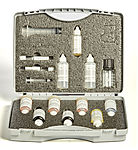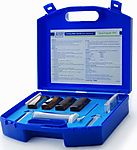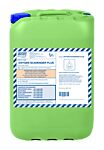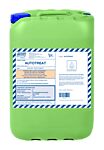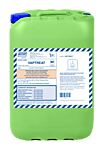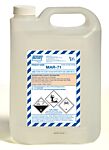


Last updated: 30/04/2025 05:20:03
NALFLEET 2000 25 LTR
Product Code
- Product group:
- 653
- Product number:
- 777710
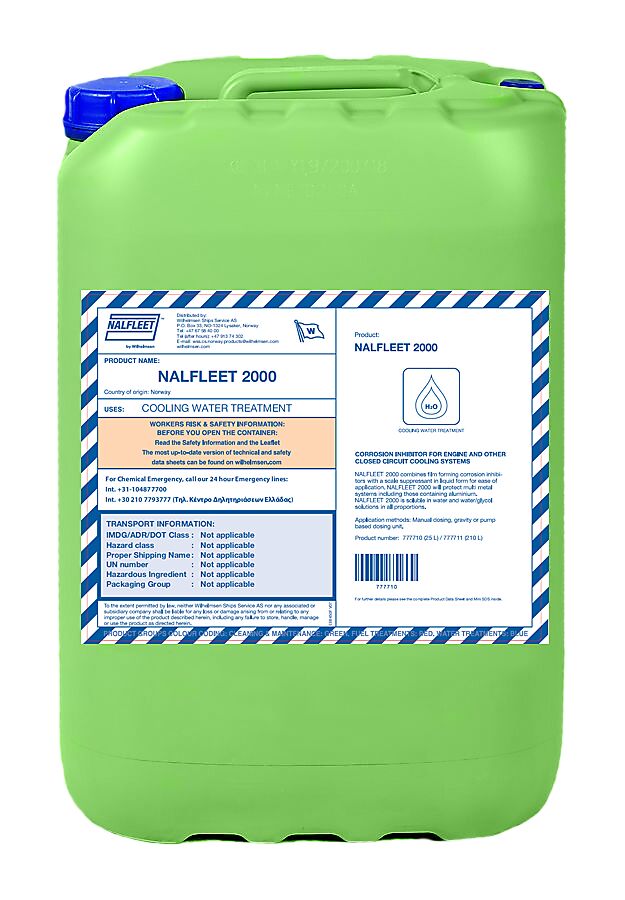
NALFLEET 2000™ cooling water treatment combines film forming corrosion inhibitors with a scale suppressant in liquid form for ease of application. NALFLEET 2000™ will protect ferrous metals, copper and copper alloys and all other metals including aluminium components. NALFLEET 2000™ is soluble in water in all proportions and does not contain chromates.

Product information
This product supersedes product no: 777704
Features
- Protects all common metals in cooling systems from corrosive attack
- Protects against cavitation erosion
- Compatible with glycols for frost protection
- Simple to control
- Safe to apply and handle
Benefits
- Minimises sludge and scale deposits
- Approved by major diesel engine manufacturers
Specification
General
| Invent Hazard Material (IMO/EU) classification | C-7 |
|---|
Physical properties
| Appearance | Red |
|---|---|
| Density [g/ml] | 1.095 - 1.125 |
| Form | Liquid |
| Materials compatibility | Stainless Steel, PVC, Polypropylene, Polyethylene, Natural Rubber, Synthetic Rubber, Viton |
| pH | 11.1 - 11.8 |
Approvals
Approved by all major engine manufacturers
Safety Data Sheet (SDS)
Documents
Directions for use
NALFLEET™ 2000 has been designed for use in all common types of engine cooling water systems. Nalfleet 2000 will protect ferrous metals, copper and copper alloys and all other metals including aluminium components. NALFLEET™ 2000 will not affect rubber gaskets or other non-metallic components within the cooling system.
For general guidance where aluminium is present:
No aluminium present - Use Rocor NB Liquid or Engine Water Treatment 9-108
With aluminium - Use NALFLEET 2000 or Cooltreat AL
Sampling and Testing
The WSS Motor Ship Test Kit (777066) provides the necessary equipment to carry out the control tests. Obtain a representative sample of the cooling water. Carry out the tests immediately after sampling (following the instructions given in the Test Kit) and log the results in Waterproof. The results should be sent to WSS as stated in the Waterproof instructions. It is important that testing is carried out at least once per week, to ensure levels of treatment are correct.
Dosing and Control
Engine cooling systems should be drained, flushed and if necessary, chemically cleaned, to remove old rust and scale deposits before treatment with NALFLEET™ 2000 can begin.
NALFLEET™ 2000 is easy to apply as received, and is fully compatible with water in ethylene glycol solutions. It contains an anti-scalant which helps to keep engine systems clean and free from corrosion and scale formation. NALFLEET™ 2000 maintains design heat transfer efficiencies and extends the life of the engine.
Cases of unusual coolant loss should be checked and remedial action taken. NALFLEET™ 2000 should be introduced during circulation of the cooling water. NALFLEET™ 2000 is best added by means of a feeder installed on a by-pass to the circulating system or in smaller systems, it can be added directly to the header tank.
Part A: Control Guideline and dosage
Nitrite Control limits for Nalfleet2000: 700 - 1,500 ppm nitrite (as NO2), recommended routine maintenance nitrite residual = 840 ppm (as NO2) The nitrite (as NO2) control guideline and dosage for Nalfleet 2000 as below:
1.Minimum = 700 ppm and required dosage of Nalfleet 2000 = 22 L/m3
2.Maximum = 1,500 ppm and required dosage of Nalfleet 2000 = 48 L/m3
3.Recommended (routine maintenance) = 840 ppm, and required dosage of Nalfleet 2000 = 27 L/m3
Note:
·To increase nitrite residual by 100 ppm, required dosage of Nalfleet2000 = 3L/m3 of distilled or technical water
·Above mentioned product dosage is an estimation only, system required dosage may varies due to water quality, system demand, and other variations.
Part B: Working examples of dosage estimation:
·New cooling system ( e.g. Nitrite residual = 0) : Recommended dosage is 27 L/m3, 840 ppm Nitrite.
·Existing operating cooling water system ( e.g. some nitrite residual presence but below recommended guideline): Assuming system measured nitrite residual at 700 ppm and to increase nitrite residual to 840 ppm, required nitrite = 140 ppm = 4.2L of Nalfleet 2000 is needed.
Part C: General Application Notes
1.The engine manufacturer's recommendations for water quality should always be complied with.
2.Chloride levels should always be as low as possible. Most engine manufacturers recommend a maximum of 50 ppm chlorides.
3.For this reason, Wilhelmsen Ships Service recommends the use of distilled water as make-up.
Related products
Is accessory to
Test Kit for Nitrite, Chloride and P Alkalinity.

